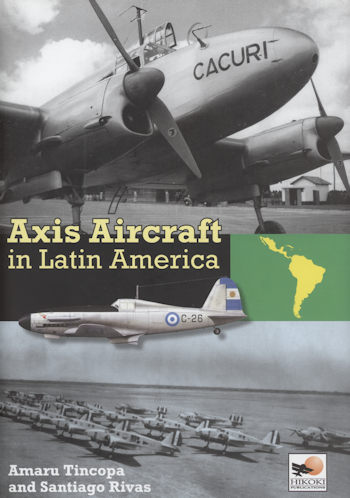 With
much 'mainstream' aviation history having been told and retold and revamped, the
enthusiast has been blessed with a number of fascinating books on subjects that
have been either partially covered or not covered in any sort of depth. This
volume takes care of one relatively unknown aviation aspect and that is the
sales and operation of aircraft from two of the major Axis powers in WWII.
With
much 'mainstream' aviation history having been told and retold and revamped, the
enthusiast has been blessed with a number of fascinating books on subjects that
have been either partially covered or not covered in any sort of depth. This
volume takes care of one relatively unknown aviation aspect and that is the
sales and operation of aircraft from two of the major Axis powers in WWII.
Of course, I am talking about Germany and Italy.
After WWI aviation was on everyone's mind. The coming of
age of the airplane was a major event of the war and the promise of widespread
air travel caught the fancy of many in Europe and North America. It was also not
unnoticed in South America and to a lesser degree in Central America.
These areas had a stronger tie to Europe than it did to
the United States so it is not unusual that those wishing to implement aviation
in these regions turned to Europe for aircraft. The major benefactor of this
quest for aircraft was Germany and particularly Junkers. The number of nascent
airlines that started out with their rugged and reliable F.13 is pretty amazing
and it is not unexpected that the larger Ju-52 would follow. Not only that, but
these aircraft had military uses as well and operated well on both floats and
wheels.
This latter capability was very much in demand as
initially, the number of available airstrips was quite limited and these planes
could operate out of harbors and on the broad rivers that are found in South
America. Of course there were more than Junkers planes. Focke-Wulf sold many
FW-44 and FW-58 aircraft, a not inconsiderable number to various military
organizations. In addition, the Italians, particularly Fiat, were successful in
selling single engine fighters like the CR.20 and CR.32. There were many more
types, but I don't want to tell all the story! Amazingly, even though parts
dried up due to the war, a large number of these types operated successfully
through the war and even into the 1950s.
Thanks to a lot of primary research by the authors (both
experts in Latin American aviation), we have a pretty complete story of the
operation of these aircraft. This includes both the civil and the military side
of things. These planes were involved in several of the wars that broke out
during this time and played an important part in events.
The book itself is arranged by country, starting with
Argentina and ending with Uruguay. Within each country, the aircraft are
described more or less in alphabetical order. Since Central America used mostly
US aircraft, that section is separate and relatively small. We then move to
visitors, which would be things like the arrival of the Do.X or long distance
flights from Italy to Brazil or the arrival of the Graf Zeppelin.
The final sections cover the boost that Germans and
Italians leaving the country after the war provided to various nation's aircraft
development and production. Civil types are then covered as is a nice section on
survivors, of which there are more than you'd think. The final section is one on
the various types by serial number that operated in the region. This is an
incredible listing and the research must have been intensive to provide this
level of information. It is all superbly illustrated with hundreds of quality
period photos and a goodly number of full color profiles as well. In all, it
makes for an outstanding book that is likely to become the standard for many
years to come. It will not be a quick read, but well worth the time. Most highly
recommended.
January 2017
Review book courtesy of
Specialty Press,
where you can order your copy of this and many other superb aviation and
modeling books. Visit their website at the link above,
use this direct link, or call them at
1-800-895-4585
If you would like your product reviewed fairly and quickly, please
contact
me or see other details in the
Note to
Contributors.
 With
much 'mainstream' aviation history having been told and retold and revamped, the
enthusiast has been blessed with a number of fascinating books on subjects that
have been either partially covered or not covered in any sort of depth. This
volume takes care of one relatively unknown aviation aspect and that is the
sales and operation of aircraft from two of the major Axis powers in WWII.
With
much 'mainstream' aviation history having been told and retold and revamped, the
enthusiast has been blessed with a number of fascinating books on subjects that
have been either partially covered or not covered in any sort of depth. This
volume takes care of one relatively unknown aviation aspect and that is the
sales and operation of aircraft from two of the major Axis powers in WWII.